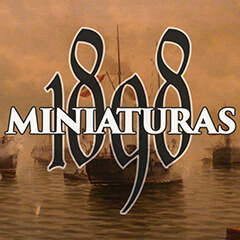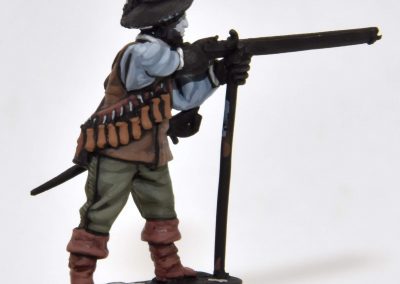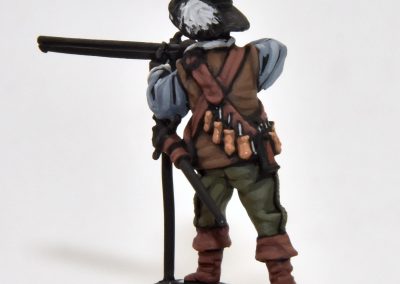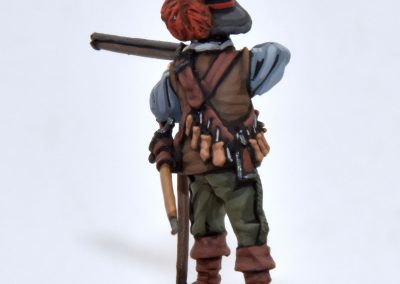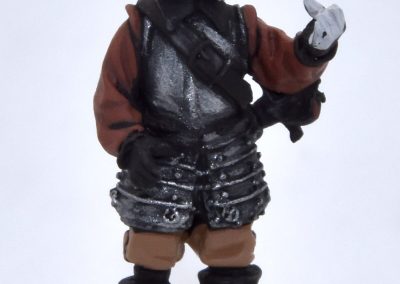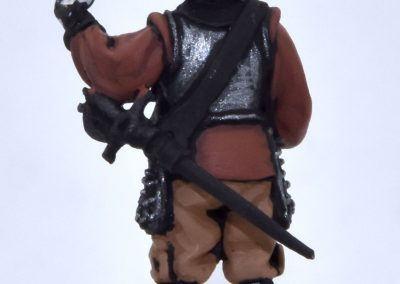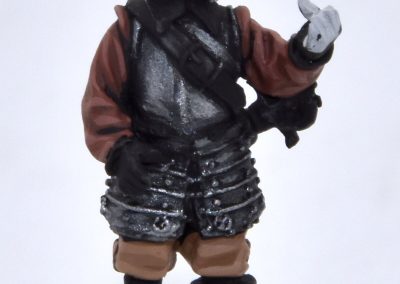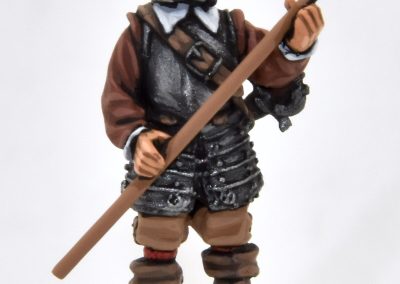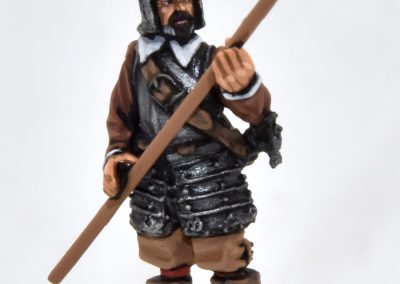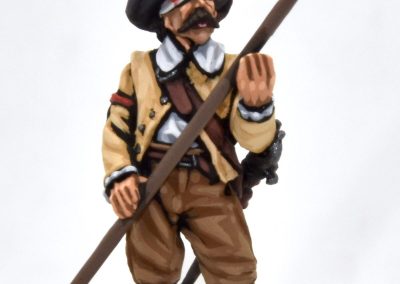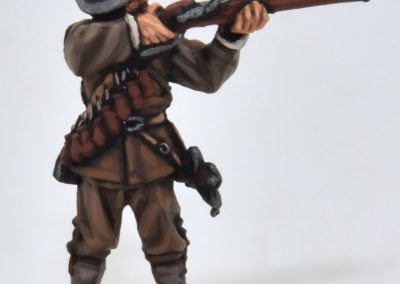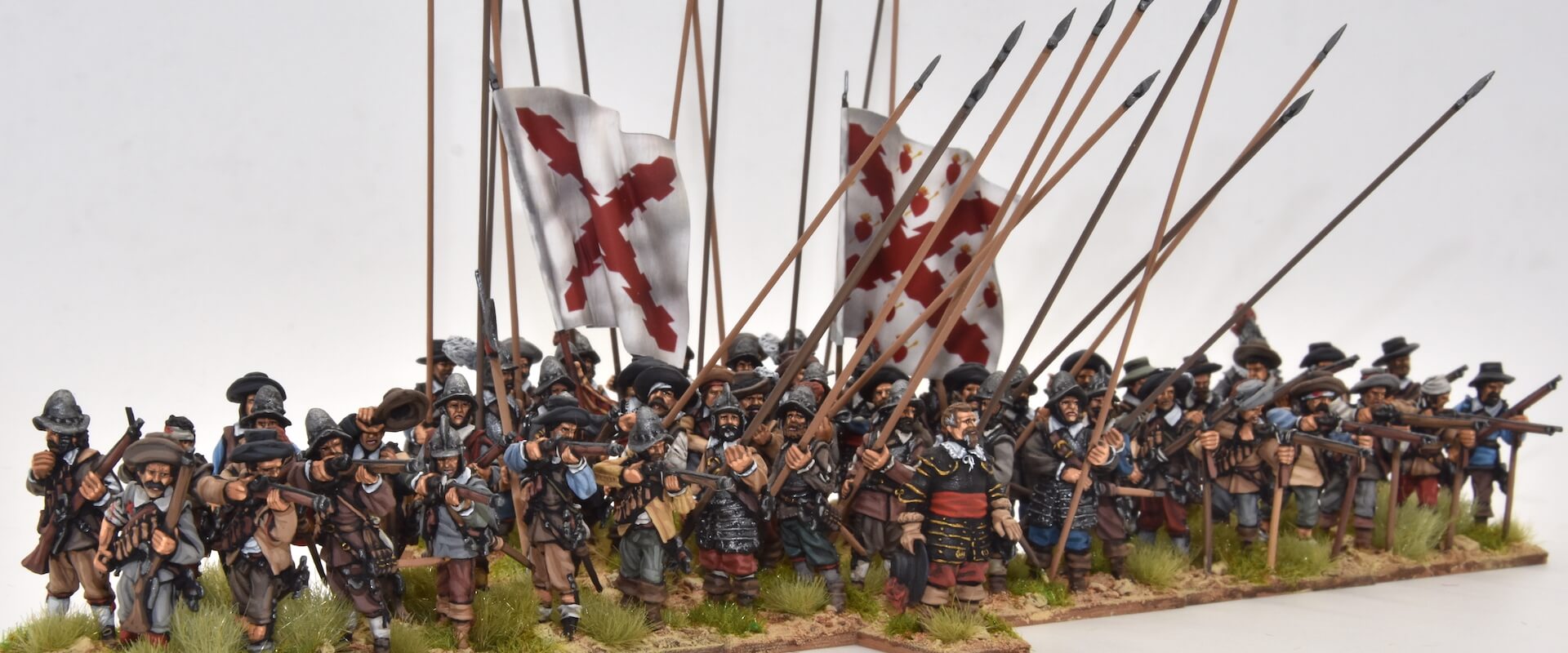Painting Spanish Tercios
Javier Gómez "El Mercenario"
1898 Miniaturas

Materials
Preparation and assemby
Uniform
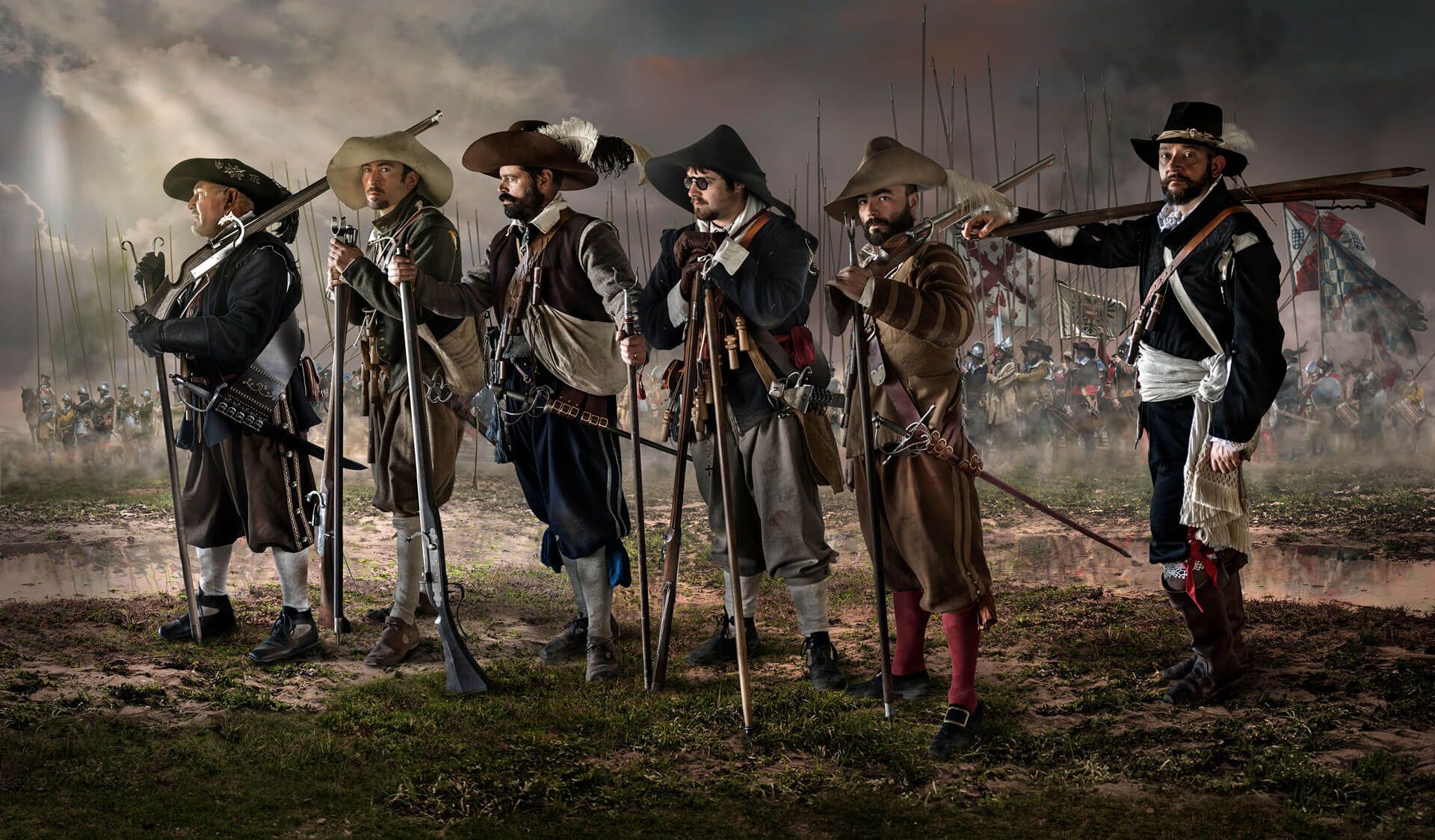
Photographer Jordi Bru’s composition, from his book Los tercios (Desperta Ferro Ediciones, 2020).
General technique
Musketeer
We will start this tutorial with the most complex and complete figure of the four, so that what we learned here will be useful in the following ones, and it is in which we will use those pastel colors we talked about before.
Firstly, we will paint the base colors of the coat (vest), with Chocolate Brown (872); of his doublet (sleeves), with French Mirage Blue (900); and of his pants, with US Dark Green (893).
We will apply a first highlight to the three colors, mixing Chocolate Brown (872) with Beige Brown (875) at 50%-50%, French Mirage Blue (900) with White (951) at 60%-40% and US Dark Green (893) with Iraqi Sand (819) at 70%-30%.
The second highlight of the vest will be almost entirely Beige Brown (875), and we will add more White (951) to the previous mix of the sleeves, and more Iraqi Sand (819) to that of the pants.
We will go to the white of the shirt, which we want to represent in a more crude or dirty tone, for which we will mix Pale Grey (990) with Sienna (113) at 70%-30% as base color, and we will lighten with white for the following highlights.
The next step will be the shoulder belt and boots, which we will paint in the same color, Saddle Brown (940) with a pinch of Black (950), approximately 90%-10%. For the first highlight we can use Saddle Brown (940) and for the third, Saddle Brown (940) with a pinch of Iraqi Sand (819), let’s say 80%-20%.
As we would have stained the cords of the twelve apostles when we paint the shoulder belt, we repaint them in black. Once dry, we paint these cords with fine lines of any gray or sand color, for greater contrast, although they could also be black or colored.
The twelve apostles were wooden containers for gunpowder, so we will use a simple combination, Beige Brown (875) as base color and Sienna (113) as the first and only light, without mixing.
The last element to highlight is the hat and the feather, which we will paint with the dry brush technique, a very useful resource for very rough surfaces, as is the case. Thus, we will normally paint the base color with a fairly dark tone, to greatly enhance the subsequent contrast, and we will make a first highlight with Cavalry Brown (982), and a second light with Red (947) mixed with Scarlet (817), both with drybrush technique. That is, with a brush that can be flat-tipped, we take paint from our palette and then “dry” the brush in toilet paper. Once the brush is “dry” (although with paint), we paint the surface in the opposite direction to the relief. In this way, the paint remains exclusively on the “prominences” and never penetrates in deep areas. It is an extremely simple technique, but also difficult to control with precision, there is always a risk of staining what is around, so in this case it would be better to paint the feathers first and then the hat, repainting with Black (950) whatever it was need. We paint the rest of the elements.
| TO PAINT | BASE COLOR | FIRST HIGHLIGHT | SECOND HIGHLIGHT |
| Coleto | Chocolate Brown (872) | Chocolate Brown (872) + Beige Brown (875) | 1st highlight + Beige Brown (875) |
| Doublet (sleeves) | French Mirage Blue (900) | French Mirage Blue (900) + White (951) | 1st highlight + White (951) |
| Breeches | US Dark Green (893) | US Dark Green (893) + Iraqi Sand (819) | 1st highlight + Iraqi Sand (819) |
| Shirt | Light Grey (990) + Sienna (113) | Color Base + White (951) | 1st highlight + White (951) |
| Hat | Black (950) | Black (950) + Neutral Grey (992) | 1st highlight + Neutral Grey (992) |
| Belts and boots | Saddle Brown (940) + Black (950) | Saddle Brown (940) | Saddle Brown (940) + Iraqi Sand (819) |
| Feathers | Chocolate Brown (872) + Black (950) | Cavalry Brown (982)* | Red (947) + Scarlet (817)* |
| Hat band | Cavalry Brown (982) + Chocolate Brown(872) | Base color + Red (947) | Red (947) + Iraqi Sand (819) |
| Musket | Chocolate Brown (872) | Chocolate Brown (872) + Sienna (113) | 1st highlight + Sienna (113) |
| Apostles | Beige Brown (875) | Sienna (113) | |
| Scabbard | Chocolate Brown (872) | Chocolate Brown(872) + Beige Brown (875) | |
| Metals (buckles, sword, gun, etc.) | Gunmetal Grey (863) |
* dry brush
Armoured pikeman
We will start with the armor, that is not only the part to be painted with the largest surface in the figure, but with which we most risk staining other parts. We do not want a clean and shiny armor like the “white” armor of the medieval knights, but one worn by the rigors of endless campaigns.
Therefore, firstly we will paint the surface of the armor with a very dark tone, Gunmetal Grey (863) mixed with Black (950) approximately 50%, as the base color.
In the first highlight, we will apply pure Mahogany Brown (846) to the coat, and Beige Brown (875) mixed with Iraqi Sand (819) at 60%-40% to the breeches.
In the second highlight, we will add a little Iraqi Sand (819) to the Mahogany Brown, but not too much (80%-20%?), since being a color from a different family will greatly alter the tone of the base. For the pants, we will add more Iraqi Sand (819) to the first light mix.
| TO PAINT | BASE COLOR | FIRST HIGHLIGHT | SECOND HIGHLIGHT |
| Armour | Gunmetal Grey (863) + Black (950) | Gunmetal Grey (863) | Natural Steel (864)* |
| Coleto | Mahogany Brown (846) + Black (950) | Mahogany Brown (846) | Mahogany Brown (846) + Iraqi Sand (819) |
| Pants | Beige Brown (875) | Beige Brown (875) + Iraqi Sand (819) | 1st highlight + Iraqi Sand (819) |
| Shirt | Light Grey (990) | Light Grey (990) + White (951) |
1st highlight + White (951) |
| Stockings | Cavalry Brown (982) + Chocolate Brown (872) | Base colour + Bermellón (947) | Red (947) + Iraqi Sand (819) |
| Belts and boots | Chocolate Brown (872) | Chocolate Brown (872) + Beige Brown (875) | Beige Brown (875) |
| Pike | Beige Brown (875) | Beige Brown (875) + Iraqi Sand (819) | |
| Scabbard | Black (950) | Chocolate Brown (872) | |
| Metals (buckles, sword, etc.) | Gunmetal Grey (863) |
* dry brush
Unarmoured pikeman
| TO PAINT | BASE COLOR | FIRST HIGHLIGHT | SECOND HIGHLIGHT |
| Doublet | Desert Yellow (977) | Desert Yellow (977) + White (951) | 1st highlight + White (951) |
| Pants | Flat Earth (983) |
Flat Earth (983) + Iraqi Sand (819) |
1st highlight + Iraqi Sand (819) |
| Shirt | Light Grey (990) | Light Grey (990) + White (951) | 1st highlight + White (951) |
| Stockings and bandage | Light Grey (990) + Siena (113) | Base color + White (951) | 1st highlight + White (951) |
| Hat | Black (950) | Black (950) + Neutral Grey (992) | 1st highlight + Neutral Grey (992) |
| Belts and shoes | Saddle Brown (940) + Black (950) | Saddle Brown (940) | Saddle Brown (940) + Iraqi Sand (819) |
| Feathers | Chocolate Brown (872) + Black (950) | Cavalry Brown (982)* | Red (947) + Scarlet (817)* |
| Armband | Cavalry Brown (982) + Chocolate Brown (872) | Base color + Red (947) | Red (947) + Iraqi Sand (819) |
| Pike | Chocolate Brown (872) | Chocolate Brown (872) + Sienna (113) | |
| Scabbard | Black (950) | Chocolate Brown (872) | |
| Metals (buckles, sword, etc.) | Gunmetal Grey (863) |
* dry brush
Arquebusier
| TO PAINT | BASE COLOR | FIRST HIGHLIGHT | SECOND HIGHLIGHT |
| Coleto | Chocolate Brown (872) | Chocolate Brown (872) + Beige Brown (875) | Beige Brown (875) |
| Doublet (sleeves) | Chocolate Brown (872) | Chocolate Brown (872) + Iraqi Sand (819) | 1st highlight + Iraqi Sand (819) |
| Pants | Chocolate Brown (872) | Chocolate Brown (872) + Sienna (113) | 1st highlight + Sienna (113) |
| Stockings | Chocolate Brown (872) | Chocolate Brown (872) + White (951) | 1st highlight + White (951) |
| Morion | Gunmetal Grey (863) + Black (950) | Gunmetal Grey (863) | Natural Steel (864)* |
| Shirt and bag | Light Grey (990) + Sienna (113) | Base color + White (951) | 1st highlight + White (951) |
| Belts | Beige Brown (875) | Sienna (113) | |
| Arquebus, scabbard and shoes | Hull Red (985) | Hull Red (985) + Mahogany Brown (846) | Mahogany Brown (846)+ Iraqi Sand (819) |
| Apostles | Hull Red (985) | Mahogany Brown (846) | |
| Metals (buckles, sword, gun, etc.) | Gunmetal Grey (863) |
Recommended readings
Albi de la Cuesta, J (2017): De Pavía a Rocroi: Los tercios españoles. Madrid. Desperta Ferro Ediciones.
Bru, J. y Claramunt, A. (2020): Los tercios. Madrid: Desperta Ferro Ediciones.
Ferrer-Dalmau, A. (2017): El pintor de batallas. Madrid: Ediciones Escultura Histórica.
Gómez Valero, J. (2015): Painting Wargame Miniatures. Barnsley: Pen & Sword.
VV.AA. (2015): Los tercios (II). 1600-1660. Desperta Ferro Especiales n.º VII.


